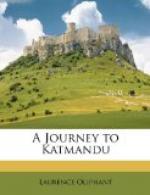I accompanied him one day on a visit to the Benares college, a handsome building in process of erection by the Indian Government. The Gothic and Oriental styles of architecture are most happily combined, and there is an airiness about the building; but this did not in any way detract from its solidity. The cost of the college and professor’s house is not to exceed 13,000 pounds; the length of the large school-room is 260 feet, its breadth 35; and there are six large class-rooms on each side.
CHAPTER III.
Jaunpore—A shooting-party—Scenes in camp and on the march—A Nepaulese dinner—Ghazipore—The Company’s stud—Indian roads—Passage of the Gograh—Jung Bahadoor’s mode of despatching an alligator.
Being anxious to visit Jaunpore, I left Benares one evening after dinner, and accomplished the distance, 36 miles, with one set of bearers, in seven hours and a half.
The first object that attracts the eye of the traveller as he enters Jaunpore is the many-arched bridge thrown by the Mahometans over the Goomte, and considered the finest built by them in India; on each side are stalls, in which sit the vendors of various wares, after the fashion of old London Bridge. On an island in the middle of the river was discovered a huge figure of a winged lion guarding an elephant, which would suggest some connexion with the sculptures found at Nineveh, and must date much further back than the erection of the bridge.
Passing through a serai, which was filled with travellers, we reached the fort, built, it is supposed, by Khan Kan, or one of the kings of the Shirkee dynasty, about the year 1260. From one of its turrets we had a magnificent view of the town and the surrounding country, while immediately below is seen the river, spanned by the picturesque old bridge, unmoved by the fierce floods which so constantly destroy those arched bridges that have been erected in India by Europeans.
The appearance of the town is diminished in size, but increased in beauty, by the many stately trees which are planted throughout it, while here and there a huge screen of some musjid rears its Egyptian-looking crest, and gives to the town an appearance peculiar to itself; Jaunpore is, in fact, the only city in India in which this style of architecture prevails.
On our way out of the fort we passed a monolithe, on which was an inscription in the same character as that on Ferozeshah’s Lath at Delhi, which has been recently translated by Mr. Prinsep. In the main gateway were some porcelain slabs which had at one time formed part of a Jain temple.




